CHEVROLET ASTRO 2003 Owners Manual
Manufacturer: CHEVROLET, Model Year: 2003, Model line: ASTRO, Model: CHEVROLET ASTRO 2003Pages: 386, PDF Size: 17.31 MB
Page 171 of 386
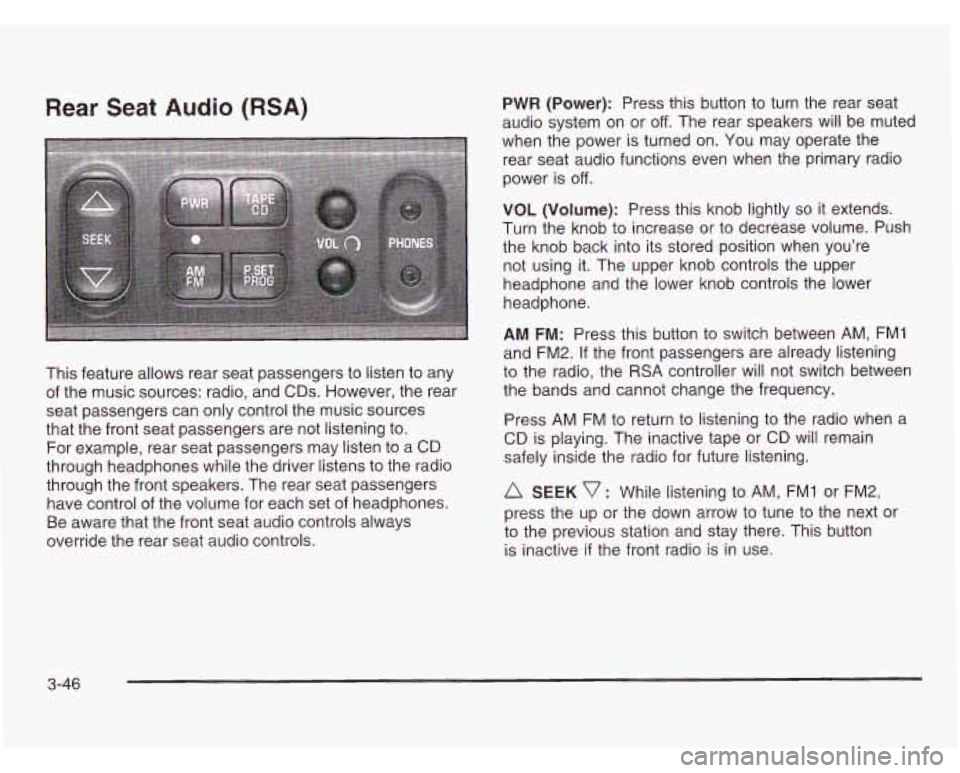
Rear Seat Audio (RSA) PWR (Power): Press this button to turn the rear seat
audio system on or
off. The rear speakers will be muted
when the power is turned on. You may operate the
rear seat audio functions even when the primary radio
power is
off.
VOL (Volume): Press this knob lightly so it extends.
Turn the knob
to increase or to decrease volume. Push
the knob back into its stored position when you’re
not using it. The upper knob controls the upper
headphone and the lower knob controls the lower
headphone.
This feature allows rear seat passengers to listen
to any
of the music sources: radio, and CDs. However, the rear
seat passengers can only control the music sources
that the front seat passengers are not listening to.
For example, rear seat passengers may listen to a CD
through headphones while the driver listens to the radio
through the front speakers. The rear seat passengers
have control of the volume for each set of headphones.
Be aware that the front seat audio controls always
override the rear seat audio controls.
AM FM: Press this button to switch between AM, FMI
and FM2.
If the front passengers are already listening
to the radio, the RSA controller will not switch between
the bands and cannot change the frequency.
Press AM FM to return to listening
to the radio when a
CD is playing. The inactive tape or CD will remain
safely inside the radio for future listening.
A SEEK v : While listening to AM, FMI or FM2,
press the up or the down arrow to tune
to the next or
to the previous station and stay there. This button
is inactive
if the front radio is in use.
3-46
Page 172 of 386
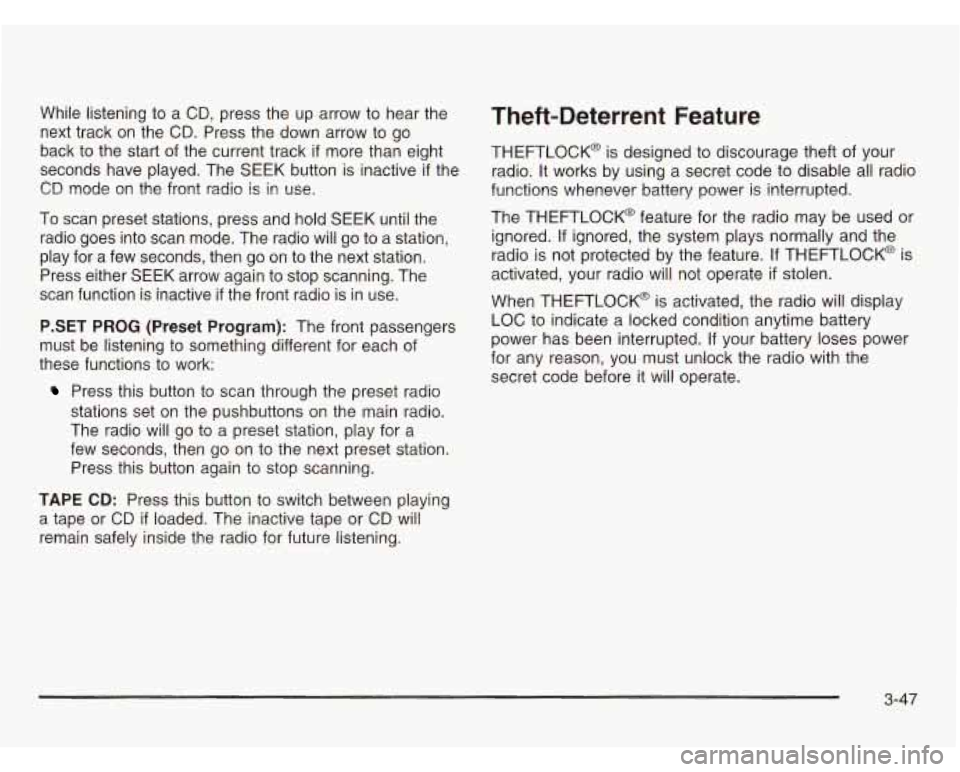
While listening to a CD, press the up arrow to hear the
next track on the CD. Press the down arrow to go
back to the start of the current track
if more than eight
seconds have played. The SEEK button is inactive
if the
CD mode on the front radio is in use.
To scan preset stations, press and hold SEEK until the
radio goes into scan mode. The radio will go to a station,
play for a few seconds, then go on to the next station.
Press either SEEK arrow again to stop scanning. The
scan function is inactive
if the front radio is in use.
P.SET PROG (Preset Program): The front passengers
must be listening to something different for each of
these functions to work:
Press this button to scan through the preset radio
stations set on the pushbuttons on the main radio.
The radio will go to
a preset station, play for a
few seconds, then go on to the next preset station.
Press this button again to stop scanning.
TAPE CD: Press this button to switch between playing
a tape or CD
if loaded. The inactive tape or CD will
remain safely inside the radio for future listening.
Theft-Deterrent Feature
THEFTLOCK@ is designed to discourage theft of your
radio. It works by using a secret code to disable all radio
functions whenever battery power is interrupted.
The THEFTLOCK@ feature for the radio may be used or
ignored.
If ignored, the system plays normally and the
radio is not protected by the feature.
If THEFTLOCK@ is
activated, your radio will not operate
if stolen.
When THEFTLOCK@ is activated, the radio will display
LOC to indicate a locked condition anytime battery
power has been interrupted.
If your battery loses power
for any reason, you must unlock the radio with the
secret code before
it will operate.
3-47
Page 173 of 386
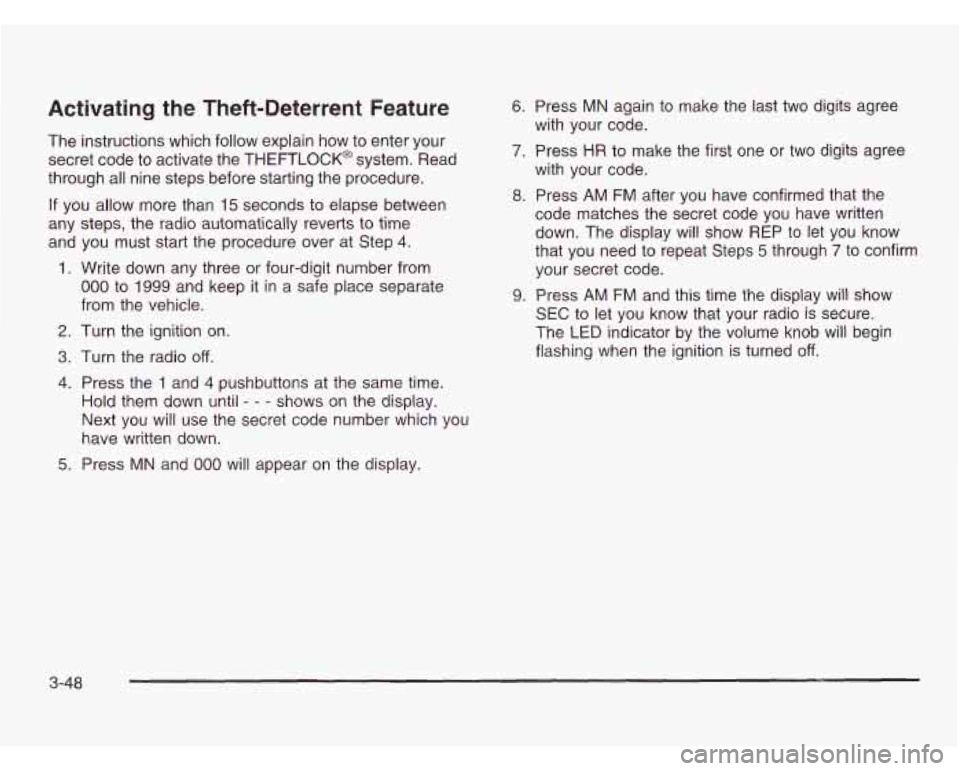
Activating the Theft-Deterrent Feature
The instructions which follow explain how to enter your
secret code to activate the THEFTLOCK@ system. Read
through all nine steps before starting the procedure.
If you allow more than 15 seconds to elapse between
any steps, the radio automatically reverts to time
and you must start the procedure over at Step
4.
1. Write down any three or four-digit number from
000 to 1999 and keep it in a safe place separate
from the vehicle.
2. Turn the ignition on.
3. Turn the radio off.
4. Press the 1 and 4 pushbuttons at the same time.
Hold them down until - - - shows on the display.
Next you will use the secret code number which you
have written down.
5. Press MN and 000 will appear on the display.
6. Press MN again to make the last two digits agree
with your code.
7. Press HR to make the first one or two digits agree
with your code.
8. Press AM FM after you have confirmed that the
code matches the secret code you have written
down. The display will show REP to let you know
that you need to repeat Steps 5 through
7 to confirm
your secret code.
9. Press AM FM and this time the display will show
SEC to let you know that your radio is secure.
The
LED indicator by the volume knob will begin
flashing when the ignition is turned
off.
3-48
Page 174 of 386
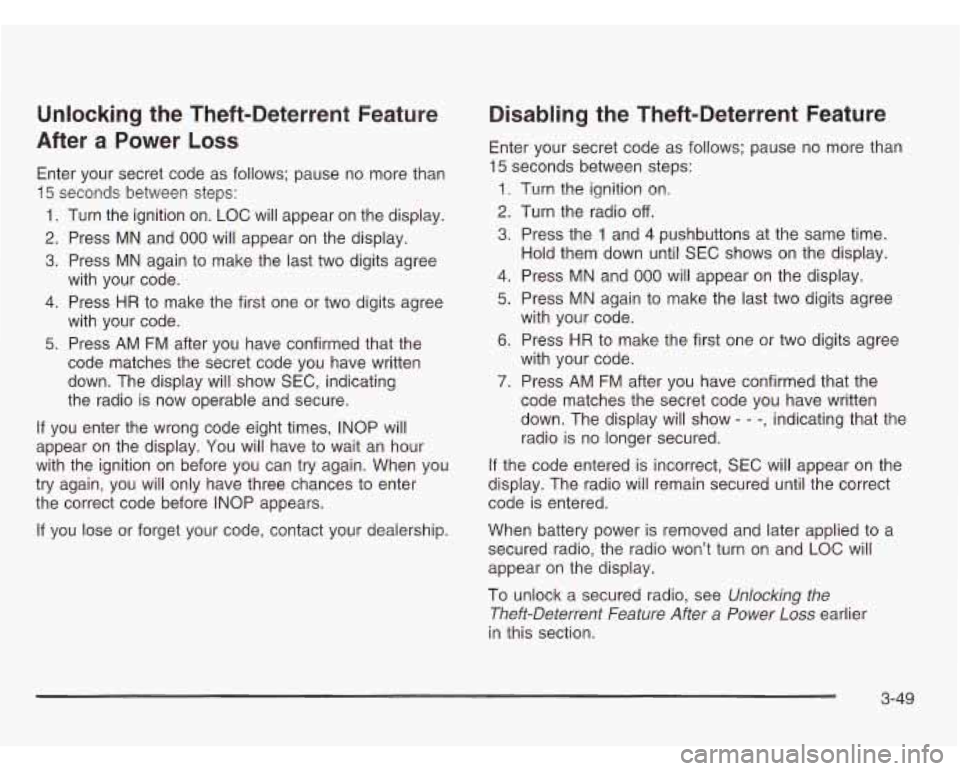
Unlocking the Theft-Deterrent Feature
After
a Power Loss
Enter your secret code as follows; pause no more than
15 seconds between steps:
1. Turn the ignition on. LOC will appear on the display.
2, Press MN and 000 will appear on the display.
3. Press MN again to make the last two digits agree
with your code.
4. Press HR to make the first one or two digits agree
with your code.
5. Press AM FM after you have confirmed that the
code matches the secret code you have written
down. The display will show SEC, indicating
the radio is now operable and secure.
If you enter the wrong code eight times, INOP will
appear on the display. You will have to wait an hour
with the ignition on before you can try again. When you
try again, you will only have three chances to enter
the correct code before INOP appears.
If you lose or forget your code, contact your dealership.
Disabling the Theft-Deterrent Feature
Enter your secret code as follows; pause no more than
15 seconds between steps:
1. Turn the ignition on.
2. Turn the radio off.
3. Press the 1 and 4 pushbuttons at the same time.
Hold them down until SEC shows on the display.
4. Press MN and
000 will appear on the display.
5. Press MN again to make the last two digits agree
with your code.
6. Press HR to make the first one or two digits agree
with your code.
7. Press AM FM after you have confirmed that the
code matches the secret code you have written
down. The display will show
- - -, indicating that the
radio is no longer secured.
If the code entered is incorrect, SEC will appear on the
display. The radio will remain secured until the correct
code is entered.
When battery power is removed and later applied to a
secured radio, the radio won’t turn on and LOC will
appear on the display.
To unlock a secured radio, see Unlocking the
Theft-Deterrent Feature After
a Power Loss earlier
in this section.
3-49
Page 175 of 386
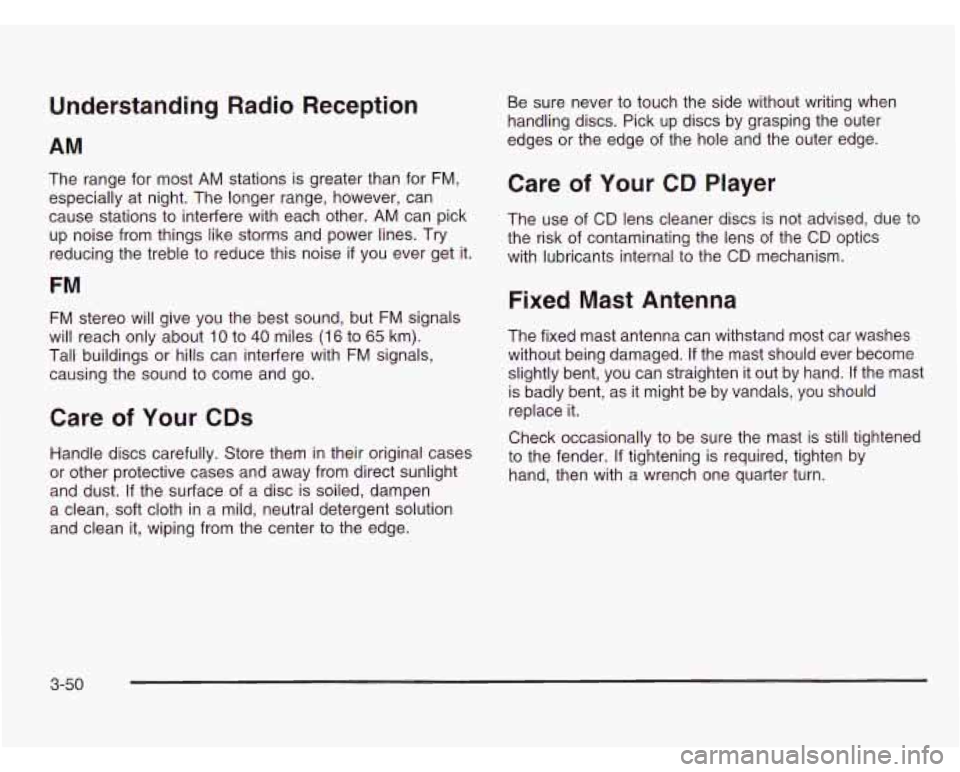
Understanding Radio Reception
AM
The range for most AM stations is greater than for FM,
especially at night. The longer range, however, can
cause stations to interfere with each other. AM can pick
up noise from things like storms and power lines. Try
reducing the treble to reduce this noise
if you ever get it.
FM
FM stereo will give you the best sound, but FM signals
will reach only about
10 to 40 miles (16 to 65 km).
Tall buildings or hills can interfere with FM signals,
causing the sound to come and go.
Care of Your CDs
Handle discs carefully. Store them in their original cases
or other protective cases and away from direct sunlight
and dust. If the surface of a disc is soiled, dampen
a clean, soft cloth in a mild, neutral detergent solution
and clean it, wiping from the center to the edge. Be
sure never to touch the side without writing when
handling discs. Pick up discs by grasping the outer
edges or the edge of the hole and the outer edge.
Care of Your CD Player
The use of CD lens cleaner discs is not advised, due to
the risk of contaminating the lens of the CD optics
with lubricants internal to the CD mechanism.
Fixed Mast Antenna
The fixed mast antenna can withstand most car washes
without being damaged.
If the mast should ever become
slightly bent, you can straighten it out by hand. If the mast
is badly bent, as it might be by vandals, you should
replace it.
Check occasionally to be sure the mast is still tightened
to the fender.
If tightening is required, tighten by
hand, then with a wrench one quarter turn.
3-50
Page 176 of 386
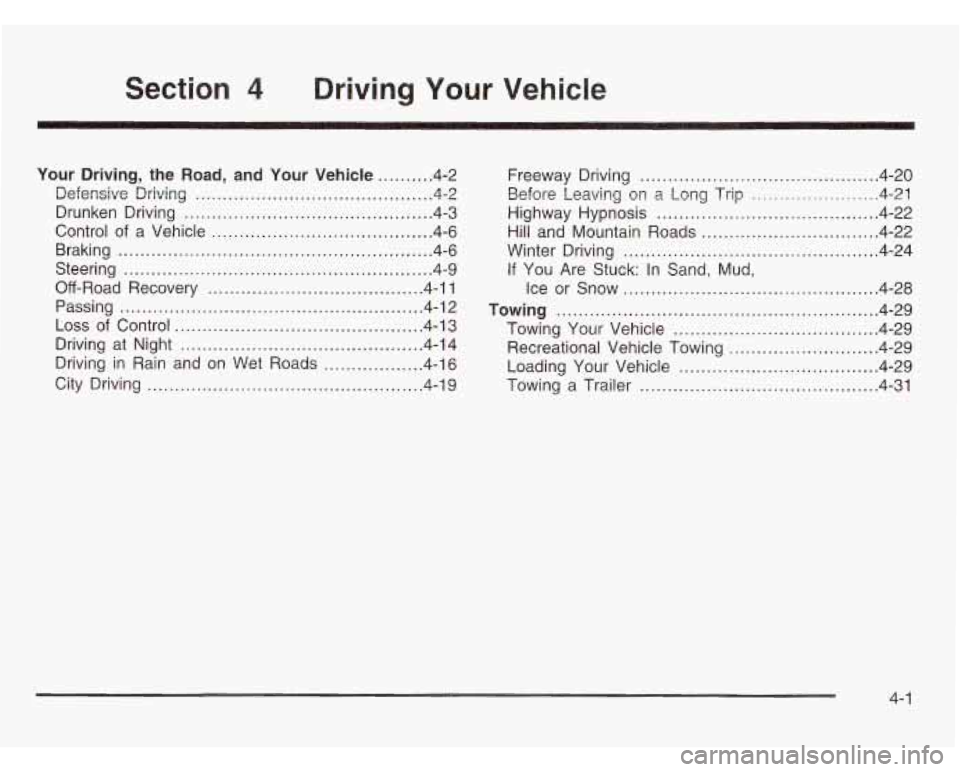
Section 4 Driving Your Vehicle
Your Driving. the Road. and Your Vehicle .......... 4-2
Defensive Driving
........................................... 4.2
Braking
......................................................... 4-6
Steering
........................................................ 4-9
Off-Road Recovery
....................................... 4-11
Passing
....................................................... 4-12
Loss of Control ............................................. 4-13
Driving at Night
............................................ 4-14
Driving in Rain and on Wet Roads
.................. 4-16
Drunken Driving
............................................. 4-3
Control of a Vehicle
........................................ 4-6
City Driving
.................................................. 4-19 Freeway
Driving
........................................... 4.20
Before Leaving
on a Long Trip ....................... 4.21
Highway Hypnosis ........................................ 4.22
Hill and Mountain Roads
................................ 4-22
Winter Driving
.............................................. 4-24
If You Are Stuck: In Sand, Mud,
Ice or Snow
..... 4.28
Towing ..... 4.29
Towing Your Vehicle
.................................. 4.29
Recreational Vehicle Towing
........................... 4.29
Loading Your Vehicle
.................................... 4.29
Towing
a Trailer ........................................... 4.31
..............................
..............................................
4- 1
Page 177 of 386
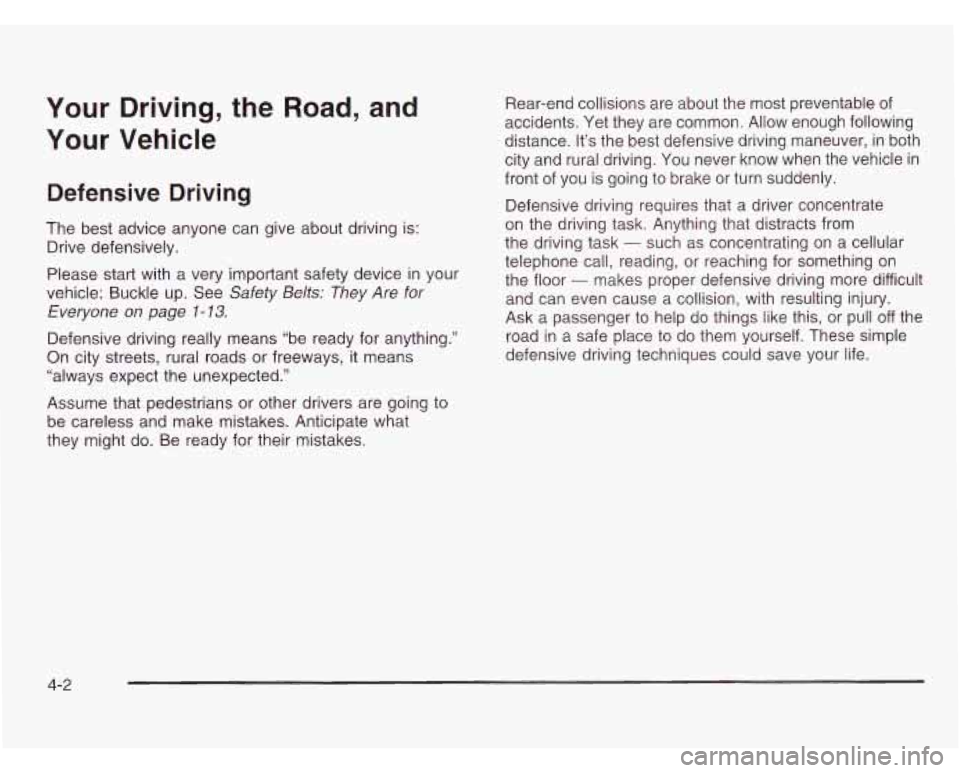
Your Driving, the Road, and
Your Vehicle
Defensive Driving
The best advice anyone can give about driving is:
Drive defensively.
Please start with a very important safety device in your
vehicle: Buckle up. See
Safety Belts: They Are for
Everyone on page
1-13.
Defensive driving really means “be ready for anything.”
On city streets, rural roads or freeways, it means
“always expect the unexpected.” Rear-end
collisions are about the most preventable of
accidents. Yet they are common. Allow enough following
distance. It’s the best defensive driving maneuver, in both
city and rural driving. You never know when the vehicle in
front of you is going to brake or turn suddenly.
Defensive driving requires that a driver concentrate
on the driving task. Anything that distracts from
the driving task
- such as concentrating on a cellular
telephone call, reading, or reaching for something on
the floor
- makes proper defensive driving more difficult
and can even cause
a collision, with resulting injury.
Ask a passenger to help do things like this, or pull
off the
road in a safe place to do them yourself. These simple
defensive driving techniques could save your life.
Assume that pedestrians or other drivers are going to
be careless and make mistakes. Anticipate what
they might do. Be ready for their mistakes.
4-2
Page 178 of 386
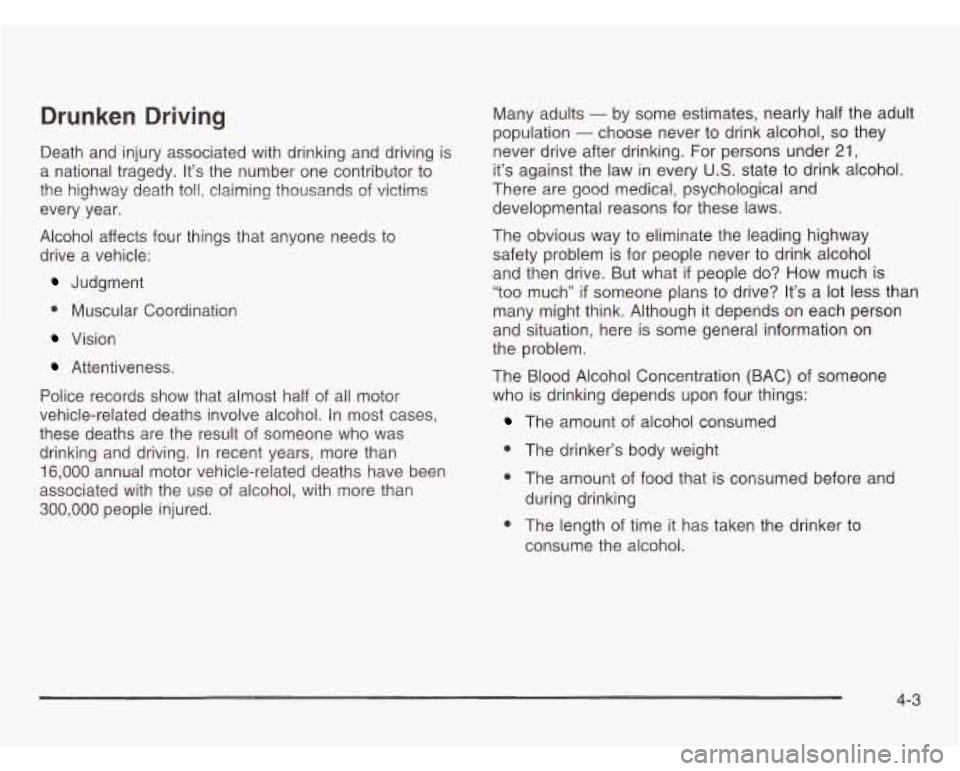
Qrunken Driving
Death and injury associated with drinking and driving is
a national tragedy. It’s the number one contributor to
the highway death toll, claiming thousands of victims
every year.
Alcohol affects four things that anyone needs to
drive a vehicle:
Judgment
0 Muscular Coordination
Vision
Attentiveness.
Police records show that almost half of all motor
vehicle-related deaths involve alcohol. In most cases,
these deaths are the result of someone who was
drinking and driving. In recent years, more than
16,000 annual motor vehicle-related deaths have been
associated with the use of alcohol, with more than
300,000 people injured. Many adults
- by
some estimates, nearly half the adult
population
- choose never to drink alcohol, so they
never drive after drinking. For persons under
21,
it’s against the law in every U.S. state to drink alcohol.
There are good medical, psychological and
developmental reasons for these laws.
The obvious way to eliminate the leading highway
safety problem
is for people never to drink alcohol
and then drive. But what
if people do? How much is
“too much”
if someone plans to drive? It’s a lot less than
many might think. Although it depends on each person
and situation, here is some general information
on
the problem.
The Blood Alcohol Concentration (BAC) of someone
who is drinking depends upon four things:
The amount of alcohol consumed
0 The drinker’s body weight
0 The amount of food that is consumed before and
during drinking
0 The length of time it has taken the drinker to
consume the alcohol.
4-3
Page 179 of 386
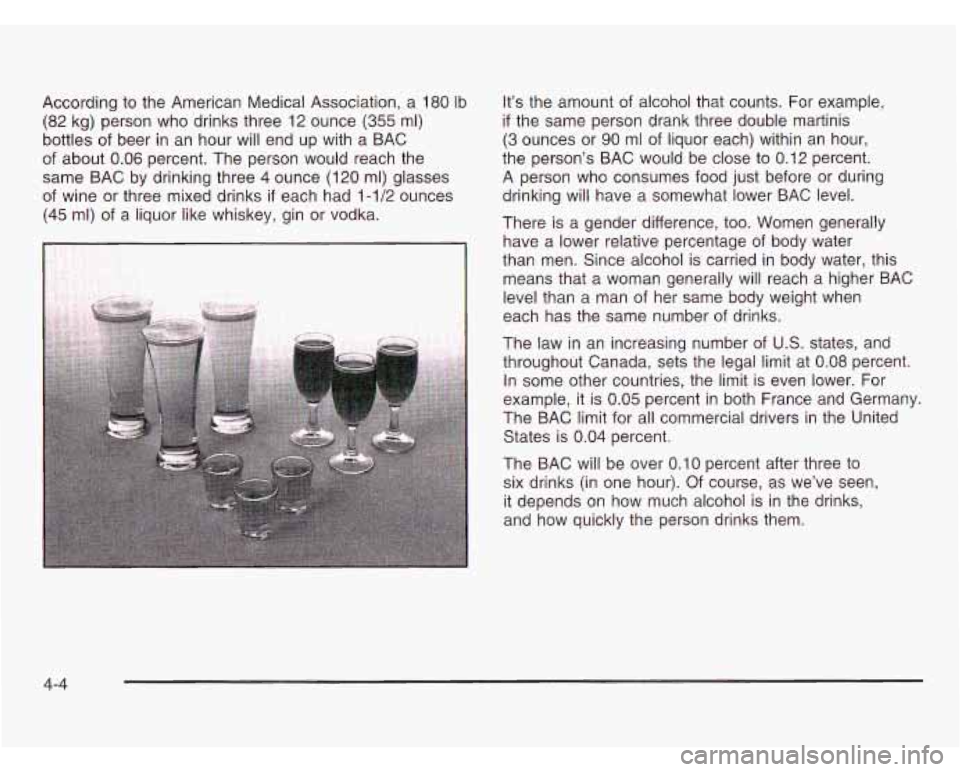
According to the American Medical Association, a 180 Ib
(82 kg) person who drinks three 12 ounce
(355 ml)
bottles of beer
in an hour will end up with a BAC
of about
0.06 percent. The person would reach the
same BAC by drinking three
4 ounce (120 ml) glasses
of wine or three mixed drinks
if each had 1-1/2 ounces
(45 ml) of a liquor like whiskey, gin or vodka.
I
It’s the amount of alcohol that counts. For example,
if the same person drank three double martinis
(3 ounces or 90 ml of liquor each) within an hour,
the person’s BAC would be close to 0.12 percent.
A person who consumes food just before or during
drinking will have a somewhat lower BAC level.
There is a gender difference, too. Women generally
have a lower relative percentage of body water
than men. Since alcohol is carried in body water, this
means that a woman generally will reach a higher BAC
level than a man of her same body weight when
each has the same number
of drinks.
The law in an increasing number of U.S. states, and
throughout Canada, sets the legal limit at 0.08 percent.
In some other countries, the limit is even lower.
For
example, it is 0.05 percent in both France and Germany.
The BAC limit for all commercial drivers in the United
States is
0.04 percent.
The BAC will be over
0.10 percent after three to
six drinks (in one hour). Of course, as we’ve seen,
it depends on how much alcohol is in the drinks,
and how quickly the person drinks them.
4-4
Page 180 of 386
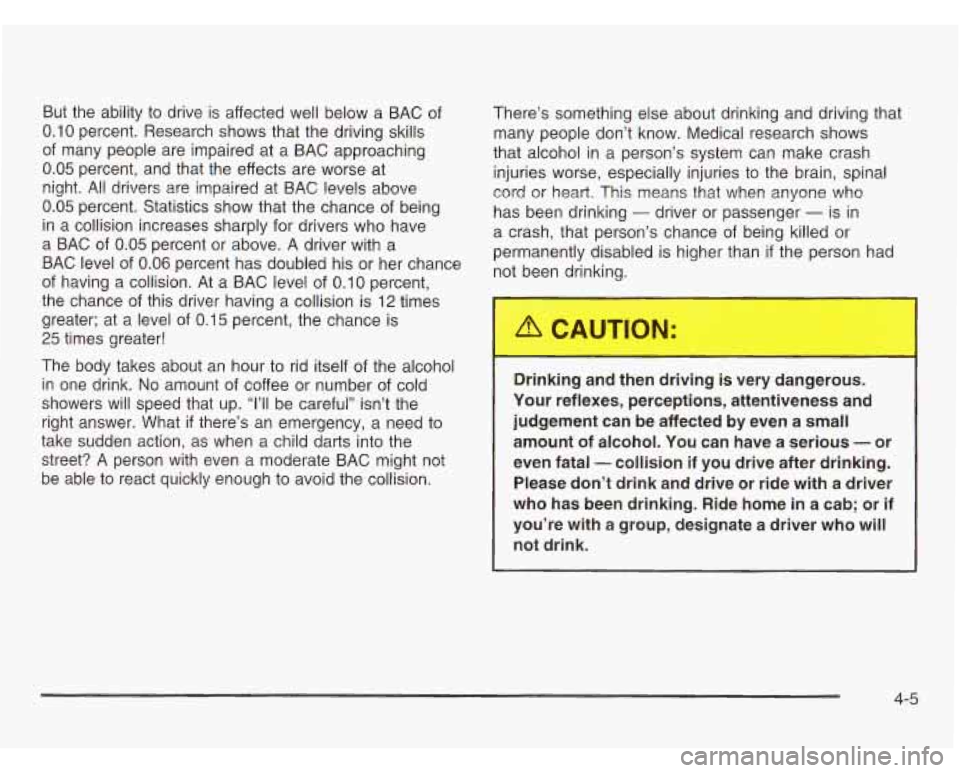
But the ability to drive is affected well below a BAC of
0.10 percent. Research shows that the driving skills
of many people are impaired at a BAC approaching
0.05 percent, and that the effects are worse at
night.
All drivers are impaired at BAC levels above
0.05 percent. Statistics show that the chance of being
in a collision increases sharply for drivers who have
a BAC of
0.05 percent or above. A driver with a
BAC level
of 0.06 percent has doubled his or her chance
of having a collision. At a BAC level of
0.10 percent,
the chance
of this driver having a collision is 12 times
greater; at a level of
0.15 percent, the chance is
25 times greater!
The body takes about an hour to rid itself of the alcohol
in one drink.
No amount of coffee or number of cold
showers will speed that up.
“1’11 be careful” isn’t the
right answer. What
if there’s an emergency, a need to
take sudden action, as when a child darts into the
street?
A person with even a moderate BAC might not
be able to react quickly enough to avoid the collision. There’s
something else about drinking and driving that
many people don’t know. Medical research shows
that alcohol in a person’s system can make crash
injuries worse, especially injuries to the brain, spinal
cord or heart, This means that when anyone who
has been drinking
- driver or passenger - is in
a crash, that person’s chance of being killed or
permanently disabled is higher than
if the person had
not been drinking.
I
Drink ...a and then __ -vin, .- . -~, --anger s.
Your reflexes, perceptions, attentiveness and
judgement can be affected by even a small
amount
of alcohol. You can have a serious - or
even fatal -collision if you drive after drinking.
Please don’t drink and drive or ride with a driver
who has been drinking. Ride home in a cab; or
if
you’re with a group, designate a driver who will
not drink.
4-5